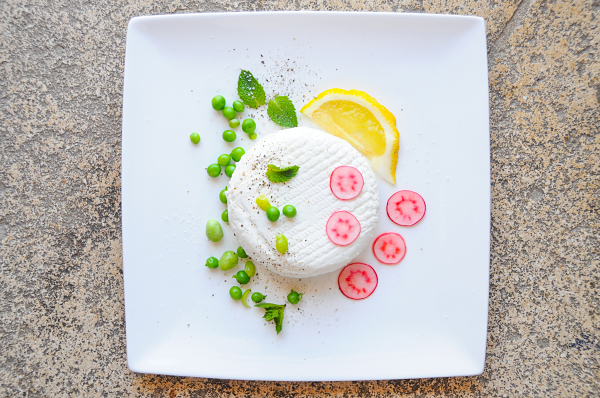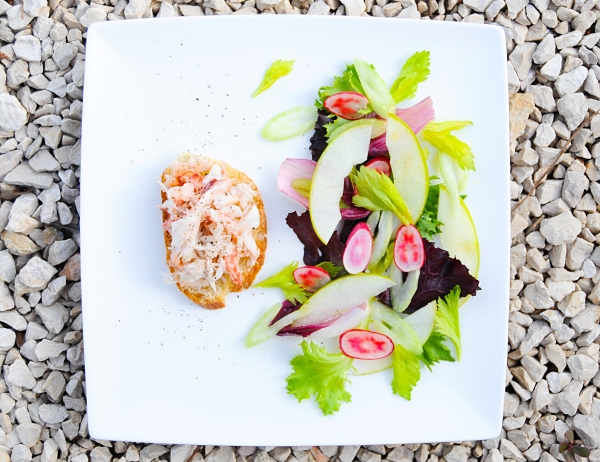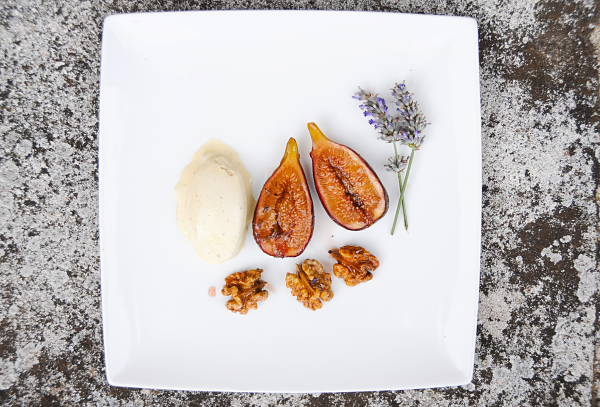It is midday on a Sunday in the busy market town of Maussane-les-Alpilles. Scanning the crowded central square, we are hoping to quickly spot the man we are here to meet. A man we are not here to meet is Jean Reno. ‘But, he sits with us, just over here!’ our actual target, duly found, entreats us in thickly accented English. ‘Come and say bonjour to Jean!’
Now, to some, this might sound like an enticing prospect indeed. Naïve as I am however, as to who exactly Jean Reno might be, (Google him if you are similarly naïve – the recognition will be instantaneous), I am preoccupied with the important matter of the day – bread! As anyone who has ever attempted to purchase fresh baguette after lunchtime on a Sunday in southern France will testify, there is simply no way, and no how. Delayed on the autoroute however, and dreading this particularly Provençal post-prandial pain drought, we had the foresight to call ahead – and the man we are here to meet is, of course, the man with the bread.
Only, now we’ve found him, at lunch with Jean Reno, and without a scrap of pain on his person! Dragged through an introduction to the famous Mr. Reno, smiling and nodding along, the miserable thought of the long breadless day ahead consumes my conscious and renders me totally incapable of recognising a face I’ve seen countless times onscreen.
The bread, it turns out, is not non-existent, only unseen, safely ensconced behind the restaurant counter inside… Jean Reno, on the other hand, is to prove subsequently more elusive. Post bread-fog, I had hoped for a second meeting in which to redeem myself, but, despite occupying neighbouring houses for the week, (and a good-deal of front-gate lingering on my behalf), it just wasn’t to be...
Fortunately what the following week lacked in celebrity spotting it made up for in good food. The tiny town of Mausanne is home to many wonderful produce shops, and one in particular that might just be the best farm shop ever – Les Jardins des Alpilles. Unassuming from the outside, inside the shelves are host to great piles of local vegetables, still soil clod and dew-dropped, fresh fruit – apples, peaches, figs, plums – leaves on and glistening, a small fromagerie (in which I attract some French tutting via profuse over-ordering), and, lest you leave without remembering to provision the all-important pain, baskets piled deep with paper-wrapped baguettes by the exit.
But summertime isn’t really for cooking (nor blogging about cooking, as it turns out, hence this summer post mid-September!). Instead, long luxurious holiday lunches are all about the illusion of plenty – a bedazzling spread, lots of plates, (of course lots of rosé), but ideally a bare minimum of preparation. The recipes below, following this, were inspired by laziness and consumed during a splendid week of long lunching this summer in Baux-de-Provence. Next time it falls to you to ‘cook’ on holiday, try them out… Being chef you’ll naturally be excused the doing of dishes, and if there is one thing that summer is truly to short for, it’s that!
Chevré, Radish, Pea, Mint
Given that this dish is really no more than an arrangement of ingredients, I thought I’d try being a little arty and came up with the presentation pictured above. If you are less into the idea of your salad as an abstract artwork, then all torn up in a typical salad-y style (below) also looks pretty.
The choice of radish is also entirely a matter of aesthetics. While the regular round sort are fine, I love the radial pink patterns found inside the longer, pointy sort. According to the internet, these are called ‘French Breakfast’ radishes – I’ve no idea if anyone actually calls them this, but you could always try asking at your local market...
Ingredients
(Serves 4)
- 1 round of fresh goat curd
- Handful of radishes – preferably the pointy, white-tipped ones
- 100g (approx.) fresh peas in their pods
- A few stems of freshly picked mint
- Extra virgin olive oil
- 1 lemon – zest and juice (& a second lemon to serve, optional)
- Sea salt flakes
- Black pepper in a grinder
Start by shelling the peas, and putting a small saucepan of water on to boil. When boiling, blanch the fresh peas for 30 seconds only, then drain and place immediately in an ice bath to cool. This will ensure that the peas retain their bright colour.
Next, take a sharp knife and slice your radishes into very thin rounds. Then pick the youngest leaves from your stems of mint, and finely grate the zest from the lemon (zest very lightly, to avoid cutting through to the bitter white pith).
To assemble, place the whole round of goat curd centrally on your serving plate, and then scatter the peas, radish slices, whole mint leaves, and lemon zest down one side of the dish, partially covering the cheese. Or, alternatively, separate the curd into small chunks and scatter these across your platter, interspersed with the radishes, peas, mint, and zest.
To dress, cut the zested lemon in half, and squeeze the juice from one half over the entire dish. Follow with a light drizzle of olive oil, a liberal scattering of salt flakes, and a fairly generous grind of black pepper.
If you wish, cut a second lemon into wedges to garnish in the style of the first picture.
Picked Crab, Celery Leaf, Green Apple & Radicchio
Fresh crab, with crusty, thickly buttered bread, is my ideal lunch pretty much anytime of year. A crunchy salad of tart apple, celery, and radicchio alongside is a particularly summery accompaniment – (consider serving also with a chilled glass of white wine, and on a vine-shaded terrace for maximum effect!).
Ingredients
(Serves 4)
- 1 large dressed crab – from a fishmonger, not a can!
- 1 medium celery stalk
- Celery leaves picked from a few stalks of celery
- 1 crisp/under-ripe granny smith apple
- 1 Radicchio (or purple endive/treviso)
- 3-4 pointy (French Breakfast) radishes
- Small handful of mixed small lettuce leaves
- 1-2 lemons
- Extra virgin olive oil
- Sea salt & freshly ground black pepper
- 1 freshly baked baguette
- Some good quality salted butter (removed from the fridge to soften prior to serving)
Assemble the salad ingredients in a large bowl: first, cut off the base of the radicchio, separating it into its individual leaves; pick the leaves from the celery; thinly slice the celery stalk on an angle; thinly slice the radishes in the same way; halve and core the apple before thinly slicing (splash these with a little lemon juice to prevent discolouration before adding to the bowl); and, lastly, add the mixed lettuce leaves.
Remove the picked meat from the crab into a bowl. Lightly mix the white meat and brown with a fork before dressing with the juice of half a lemon, along with a sprinkling of salt and a little freshly ground black pepper.
Diagonally cut four thin slices from your baguette, and butter generously before lightly piling some crab meat high on each.
Lastly, dress the salad with a good squeeze of lemon, a light drizzle of olive oil, and some salt and pepper.
Arrange as you wish, either on individual serving plates (as pictured), or on a platter to share.
Sea Scallops, Balsamic, Orange & Fennel
This recipe does require a little ‘slaving over a hot stove,’ but under a minute's worth, so even the laziest summer cook should still manage to cope! If you wanted to stick fervently to a no-stove policy, you could thinly slice the raw scallops, dress with a little lemon as well as the balsamic, and serve this dish as a carpaccio instead.
Ingredients
(Serves 4)
- 12 trimmed scallops
- 2 small oranges
- 1 bulb of fennel
- A few sprigs of dill
- 2-3 tablespoons of good quality balsamic vinegar
- ½ a lemon
- Extra virgin olive oil
- Sea salt & freshly ground black pepper
Remove the skin from the oranges by first slicing off the top and tail, then, with the orange positioned one cut side down to chopping board, use a small knife to remove the skin, top to bottom, following the natural lines of the fruit, (and taking care not to remove too much flesh in the process!). Once you’ve removed the skin, carefully slice each orange into six rounds, removing any seeds that you come across as you go.
Cut the base from the fennel bulb and, ideally using a mandolin, shave the entire head into thin rounds. Place the cut fennel into a large bowl, separating the layers of the rounds using your fingers as you do so. Then, squeeze over the juice of half a lemon, dress with a glug of olive oil, and season with some sea salt and freshly ground black pepper. Toss to combine.
Once the scallops hit the pan, they will cook very quickly, so it helps to have the serving plates well prepared ahead of time. To do this:
Place three rounds of orange on each plate, and then carefully arrange a few shavings of the dressed fennel around these.
Ready the dill sprigs for scattering by separating these into a number of much smaller fronds, then put aside until needed.
Prior to cooking, check that the scallops are well trimmed, (look for any tough connective tissue on the edge of each – this is the ‘foot’ of the scallop and it is not always removed by the fishmonger – simply slice off using a small knife if present). Now dress the trimmed scallops very lightly with a little olive oil, then ready large skillet (or frying pan) by placing it over a high flame to heat. Make sure to give the pan sufficient time to heat up – we want the scallops to sear and caramelise immediately on contact – a couple of minutes heating should do it.
Once hot, add all 12 scallops to the pan, and leave these to cook, without turning for between 30 seconds and 1 minute, depending on the size of the scallops. After this length of time, peek beneath one scallop, if it is still pale, continue cooking a little longer, if it is a nice carmelised brown, you are ready to flip them over and cook for the same amount of time on the other side.
In the final few seconds of cooking, splash in the balsamic vinegar, tossing the scallops to coat, before seasoning with a little salt and freshly ground black pepper and removing from the heat.
Position the scallops on your serving plates, each one atop a round of orange. Drizzle any extra balsamic sauce that is left in the pan directly over the scallops. Finish by scattering across the dill fronds that you picked and put aside earlier.
Roasted Black Figs, Lavender, Honey, Walnuts
The postcard Provencal scene is a field of lavender – row upon row of flowering purple, disappearing towards the horizon. Some of these famous fields, as it happens, are not far from where we were based, but all completely over-run with tourists, crouching with their cameras among the bushes, trying to replicate the postcard picture! My own take on the cliché is culinary instead - left to infuse a while in some honey, the lavender in this dish seems to deliciously scent more than flavour the roasted figs.
On the question of figs, you can use any sort you have on hand, but I love the elegant elongated shape of the small black figs that are ubiquitous in summertime Provence.
With regard to honey, because we will be flavouring this with the lavender flowers, it’s best to use a neutral variety as opposed to anything with a strong flavour of its own.
Walnuts in their shells are a recent obsession of mine – worth the extra bother with a nutcracker I promise! Once shelled and packaged, they seem to me to immediately to lose their flavour and become musty.
Finally, I could not decide whether I preferred this dish as dessert or a kind of cheese course, so I’ve included pictures of both sweet and savoury options. Choose one, or offer both!
Ingredients
(Serves 4)
- 4 ripe black figs
- 6 sprigs of lavender in flower (plus extra to garnish if you wish)
- Approx. 100ml of runny honey
- 8 walnuts in their shells
- Small knob (approx. 1 tablespoon) of unsalted butter
To serve, either:
Toasted baguette, fresh goat’s cheese, and black pepper
Or
Vanilla ice cream
To infuse the honey with the scent of lavender, place your lavender sprigs on a clean tea towel, fold this over to cover the sprigs, then lightly bruise using the heel of your hand. This should release the scent of the lavender without causing the sprigs to come apart too dramatically, (which would become problematic later when it comes to separating the honey from the sprigs).
Next, place the bruised lavender in the base of a shallow bowl and pour the honey over the top. Leave this somewhere warm to infuse, either overnight, or for at least 5 hours. During this time, the lavender will slowly infuse the surround honey with its delicate scent.
Pre-heat the oven to 180°C. How you’d like to prepare the figs is up to you, either slice the stem from the fig and slice a cross shape down into the fruit (as per the preceding photo), or halve each one by cutting longitudinally, from stem to base, (as per the pictures of the plated dish), and arrange in a baking dish.
Carefully remove the lavender sprigs from the honey – it’s not a problem if a the odd bit of lavender comes off and remains stuck in the honey, but do the best you can. Drizzle the scented honey over the cut figs, and then place in the oven for approximately 15-20 minutes (or until the figs have become soft, but not so soft as to fall apart).
While the figs are in the oven, crack the walnuts, attempting to remove the nut in two unbroken hemispheres from its shell – lightly toast these in unsalted butter, for approximately 3 minutes, over medium heat in a small frying pan.
When the figs are done, place either one whole, or two halves, per plate – and accompany with either sweet or savoury: a scoop of vanilla ice cream, or a slice of toasty baguette topped with fresh chevré and plenty of black pepper. Additional sprigs of lavender to garnish are a scenic reminder of all that time spent infusing, and may serve as a prompt for anyone struggling to place the flavour!



















